
Myrmica rubra, also known as the common red ant or the European fire ant, is a species of ant of the genus Myrmica. It is found across Europe and is now invasive in some parts of North America and Asia. It is mainly red in colour, with slightly darker pigmentation on the head. These ants live under stones and fallen trees, and in soil. They are aggressive, often attacking rather than running away, and are equipped with a stinger, though they lack the ability to spray formic acid like the genus Formica.

An ant colony is a population of ants, typically from a single species, capable of maintaining their complete lifecycle. Ant colonies are eusocial, communal, and efficiently organized and are very much like those found in other social Hymenoptera, though the various groups of these developed sociality independently through convergent evolution. The typical colony consists of one or more egg-laying queens, numerous sterile females and, seasonally, many winged sexual males and females. In order to establish new colonies, ants undertake flights that occur at species-characteristic times of the day. Swarms of the winged sexuals depart the nest in search of other nests. The males die shortly thereafter, along with most of the females. A small percentage of the females survive to initiate new nests.

Carpenter ants are large ants indigenous to many forested parts of the world.

Dorylus, also known as driver ants, safari ants, or siafu, is a large genus of army ants found primarily in central and east Africa, although the range also extends to southern Africa and tropical Asia. The term siafu is a loanword from Swahili, and is one of numerous similar words from regional Bantu languages used by indigenous peoples to describe various species of these ants. Unlike the New World members of the former subfamily Ecitoninae, members of this genus form temporary subterranean bivouacs in underground cavities which they excavate and inhabit - either for a few days or up to three months. Also, unlike some New World army ants, driver ants are not specialized predators of other species of ant, instead being more generalistic with a diet consisting of a diversity of arthropods. Their colonies are enormous compared to other ant species, and can contain over 20 million individuals. As with their American counterparts, workers exhibit caste polymorphism with the soldiers having particularly large heads that power their scissor-like mandibles. They are capable of stinging, but very rarely do so, relying instead on their powerful shearing jaws. A large part of their diet consists of earthworms. Driver ant queens are the largest living ants known, with the largest measuring between 40 - 63 millimeters in total body length depending on their physiological condition.

The name army ant (or legionary ant or marabunta) is applied to over 200 ant species in different lineages. Because of their aggressive predatory foraging groups, known as "raids", a huge number of ants forage simultaneously over a limited area.
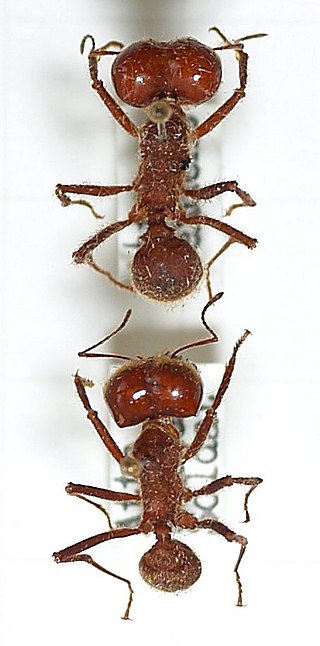
Atta sexdens is a species of leafcutter ant belonging to the tribe Attini, native to America, from the southern United States (Texas) to northern Argentina. They are absent from Chile. They cut leaves to provide a substrate for the fungus farms which are their principal source of food. Their societies are among the most complex found in social insects. A. sexdens is an ecologically important species, but also an agricultural pest. Other Atta species, such as Atta texana, Atta cephalotes and others, have similar behavior and ecology.

The dwarf honey bee, Apis florea, is one of two species of small, wild honey bees of southern and southeastern Asia. It has a much wider distribution than its sister species, Apis andreniformis. First identified in the late 18th century, Apis florea is unique for its morphology, foraging behavior and defensive mechanisms like making a piping noise. Apis florea have open nests and small colonies, which makes them more susceptible to predation than cavity nesters with large numbers of defensive workers. These honey bees are important pollinators and therefore commodified in countries like Cambodia.

Eciton burchellii is a species of New World army ant in the genus Eciton. This species performs expansive, organized swarm raids that give it the informal name, Eciton army ant. This species displays a high degree of worker polymorphism. Sterile workers are of four discrete size-castes: minors, medias, porters (sub-majors), and soldiers (majors). Soldiers have much larger heads and specialized mandibles for defense. In lieu of underground excavated nests, colonies of E. burchellii form temporary living nests known as bivouacs, which are composed of hanging live worker bodies and which can be disassembled and relocated during colony emigrations. Eciton burchellii colonies cycle between stationary phases and nomadic phases when the colony emigrates nightly. These alternating phases of emigration frequency are governed by coinciding brood developmental stages. Group foraging efforts known as "raids" are maintained by the use of pheromones, can be 200 metres (660 ft) long, and employ up to 200,000 ants. Workers are also adept at making living structures out of their own bodies to improve efficiency of moving as a group across the forest floor while foraging or emigrating. Workers can fill "potholes" in the foraging trail with their own bodies, and can also form living bridges. Numerous antbirds prey on the Eciton burchellii by using their raids as a source of food. In terms of geographical distribution, this species is found in the Amazon jungle and Central America.

Nuptial flight is an important phase in the reproduction of most ant, termite, and some bee species. It is also observed in some fly species, such as Rhamphomyia longicauda.

Harpagoxenus sublaevis is a species of ant in the subfamily Myrmicinae. It is found in Austria, France, Germany, Italy, and Switzerland.
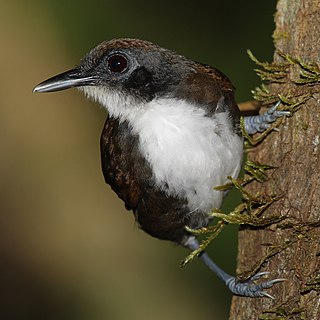
Ant followers are birds that feed by following swarms of army ants and take prey flushed by those ants. The best-known ant-followers are 18 species of antbird in the family Thamnophilidae, but other families of birds may follow ants, including thrushes, chats, ant-tanagers, cuckoos, motmots, and woodcreepers.

Carebara diversa is a species of marauder ant widely distributed throughout Asia.

Dorylus laevigatus is a member of the army ant genus Dorylus, or Old World army ants. More specifically known as "driver ants", the genus Dorylus is abundant throughout Africa and stretches into tropical Asia, where D. laevigatus is primarily found. They are a eusocial colony-forming species, which live primarily underground, rarely venturing to the surface for any reason. D. laevigatus colonies are small for army ants, estimated averages falling between 30,000 and 1,000,000 individuals.
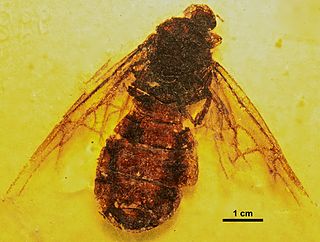
Titanomyrma is a genus of extinct giant ants which lived during the Eocene. The type species Titanomyrma gigantea and the smaller Titanomyrma simillima are known from the Eocene of Germany, while the third species Titanomyrma lubei, is known from Wyoming, United States. The presence of Titanomyrma in North America was considered to indicate "the first reported cross-Arctic dispersal by a thermophilic insect group". However a queen reported from Upland temperate shales in British Columbia raised questions on the exact thermophilic nature of the genus. The type species of this genus, T. gigantea, is the largest-known fossil or extant species of ant in the world.
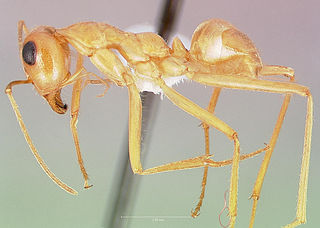
Myrmecocystus mexicanus is a species of ant in the genus Myrmecocystus, which is one of the six genera that bear the common name "honey ant" or "honeypot ant", due to curious behavior where some of the workers will swell with liquid food until they become immobile and hang from the ceilings of nest chambers, acting as living food storage for the colony. Honey ants are found in North America, Australia, and Africa. Ant species belonging to the genus Myrmecocystus reside in North America. M. mexicanus in particular is found in the southwestern United States and parts of Mexico.

The Central American paper wasp is a nocturnal eusocial wasp. It is famous for its swarm based emigration behavior, and is native to the lowlands of Central and northern South America. This species has developed special night vision adaptations to facilitate their night-time swarming and foraging behavior and has important medicinal properties for the Pankararú people of Brazil.
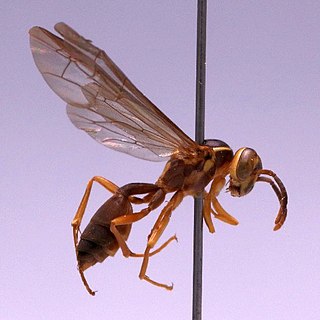
Angiopolybia pallens is a species of social wasp predominantly found in South America. The wasp is generally seen in Brazilian rainforests. This species was discovered by Lepeletier in 1836. It typically feeds on nectar and carrion. In fact much of its feeding behavior and impact on humans is centered on feeding on animal carcasses. The wasp species displays a caste differentiation that can be seen by difference in ovarian development. Additionally they have a unique colony establishment procedure. It begins with a few individuals from the nest leaving to find a good site and then the rest of the colony follows using specific communication signals that are further discussed in this article.

Protonectarina sylveirae, commonly referred to as the Brazilian wasp, is a neotropical swarm-founding wasp species that ranges widely across South America. This species relies heavily on the consumption of animal protein rather than nectar. P. sylveirae preys heavily on agricultural pests to coffee crops, keeping pest populations low.
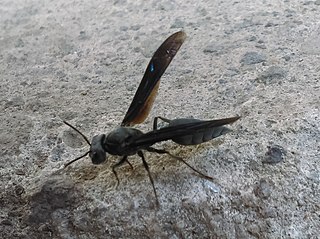
Synoeca septentrionalis is one of five species of wasps in the genus Synoeca. It is a swarm-founding wasp that is also eusocial, exhibiting complicated nest structure and defense mechanisms and a colony cycle including a pre-emergence phase and a post-emergence phase. It is typically found in areas from Central to South America. This wasp is one of the larger species of paper wasps and exhibits multiple morphological adaptations as a result of this. Synoeca septentrionalis is known for possessing a very painful sting.
There are 803 species of ants currently known in the Democratic Republic of the Congo. Unusually, there are no known introduced species in this region. The majority of species occur in the Congolese rainforest and Central Congolian lowland forests.

















